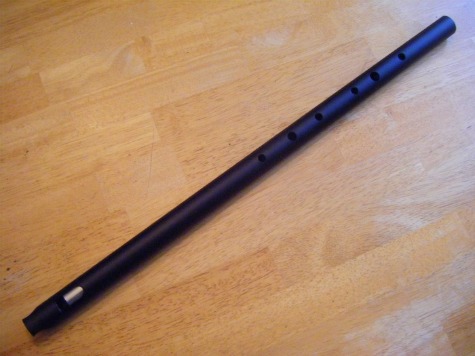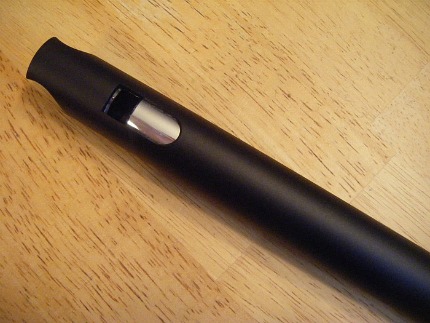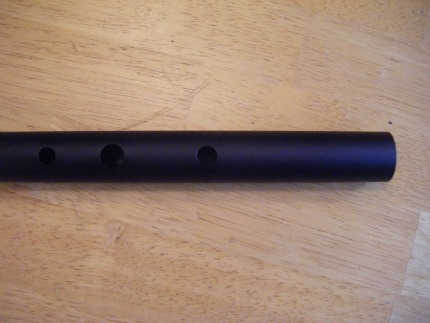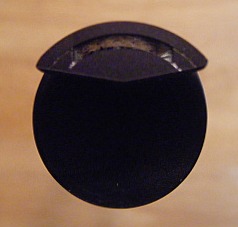Maker - MK whistles (Misha Somerville) http://mkwhistles.com
Material - Aluminum and Brass
Dimensions: Length - 22 7/16ths"
Distance between 1st and 3rd bottom holes - 2 15/16ths"
Diameter of 2nd hole from bottom - 7/16ths"
Bore - 7/8ths"
Weight - 7 oz
Price at time of review - 100 lbs direct from Maker
As
you may know from reading my other reviews, the original MK line has
remained one of my favorite and most highly praised make of low
whistles. So I was both excited and a little nervous when I heard that
Misha was coming out with a new line of whistle. When the Kelpie
was first released, Misha stated it was designed specifically with the
begining to intermediate whistler in mind (although interestingly alot
of the verbiage saying that has since been removed from the MK site).
When I asked him directly what he meant by that, he told me that he was
trying to make the higher notes easier to play, or, if I understood him
correctly, easier to control, as well as make the whistle more
affordable. Once again Misha and his staff at MK whistles were great to
work with and ordering the whistle was a pleasant experience. And on a
quick side note, with the addition of the Kelpie, MK now refers to
their original model as the "MK Pro".








Appearance:
The Kelpie features MK's new "Satin" anodized finish rather than the
original polished finish of the MK pro (although the MK pro is now
available in the Satin finish, the Kelpie is not available in the
polished, most likely to keep the cost down I would think). The Kelpie
is not available with a tuning slide, which Misha did say was to help
keep the cost down. I personally love the looks of non-tunable low
whistles, and wish Misha would offer the pro model without a tuning
slide as well! As of this writing, the Kelpie was only available in
grey, which I believe is supposed to be it's standard color, but the
initial run also included some in black, which I was excited about as I
think the Satin finish looks awesome/best in black. While the polished
finish is definately snazzy and eye catching, the Satin finish has the
added bonus of giving the whistle a better grip, as the polished can be
slightly slippery. The Kelpie definately lives up to it's pedigree
as an MK in quality of construction, all it's lines are straight and
smooth, with no rough or uneven edges or tool marks. It certainly feels
and looks like a top of the line, professional instrument, as one would
expect from an MK. It features pretty much the same construction as the
MK pro with the same mouthpiece, fipple and windway design, although
the window looks just a hair larger on the Kelpie. MKs remain one of,
if not the best looking low whistles out there.
Tone: When Misha first announced the Kelpie, as previously stated he said that this whistle was designed with the beginner in mind, and as such he said he had sacrificed a little on the tone to make the whistle easier to play. On his website he reffered to the Kelpie as having a "shallower" tone when compared to his original model. To me, it sounds like the Kelpie is missing just that extra bit of complexity of tone that makes the MK pro sound, well like an MK pro. Not to say that the Kelpie sounds bad, as it does not by any strectch of the imagination. It is full, round, a bit mellower than the original MK and actually has a fatter and rounder low fundamental than it's older brother (although the MK pros tone is richer). It has a nice amount of breathiness inherent in the tone, enough to make it sound like a whistle and not a flute, but not too much either (although just slightly more than the original MK).
Volume: I would describe the volume of this whistle as being fairly loud. It is well balanced between octaves with the exception of the top few notes, which are naturally louder as you have to blow harder to keep them from dropping down the octave. The low fundamental is probably the best feature of this whistle, as it is nice and fat and loud, similar to a Burke Viper low D. I would think this whistle would work well in a session, especially where you don't have to worry about overblowing as much as on other low whistles.
Backpressure/air requirement:This whistle has moderate to low backpressure, with a moderate to high breath requirement, especially in the second octave. The high A and B notes require that you really lean into them to keep them from dropping back down into the first octave. I found this strange as Misha Somerville specifically said he designed the Kelpie to make the top notes eaiser to play. Perhaps he was thinking beginners have a tendency to overblow? I will conceded that as the original MK model is now my main go to low D, perhaps I am just used to how that whistle plays. But I have to say I found the original MK model almost effortless to play from the get go. If anything I would say that the Kelpie's lower notes are easier to play, as you can really lean into them where as the MK pro can be just a little, slightly touchy on the bottom if you are not careful.
Responsiveness: The Kelpie is not quite as responsive as it's older sibling, but considering the MK pro is the most responsive low whistle I have ever played, that means the Kelpie is still pretty darn responsive. Ornaments were still nice and snappy and clean.
Clogging: May clog after prolonged play, but not a noticable issue. I suspect the curved, rounded windway helps with this.
Tuning: When put to the tuner, the whole whistle was on average about ten cents sharp, but was fairly well intune with itself otherwise. Exceptions included both F#'s which were only five cents sharp (or five cents flat to the rest of the whistle depending on how you want to look at it) and the C# which was spot on (or again, ten cents flat). C natural was good with OXXOOO fingering. The first octave D and E as well as the second octave D would go another five cents or so sharp if pushed, but this was controlable by the player and five cents either way is barely noticeable to the ear anyway, unless I suppose if you have perfect pitch! Most notably, the second octave A and B were well in tune with the rest of the whistle, even though as mentioned you really have to lean into them and blow harder to keep them from falling back down into the first octave. Most other low whistles when blown harder on these two notes would logically go sharp, but the Kelpie impressively does not.
Sound clip: While I am still sadly lacking the right hardware/software combination to be able to make a sound clip of the specific whistle in this review, here is a link to a video on youtube that someone else (no, that is not me) made using a Kelpie. While a poor example of how to finger a low whistle (where's your grip man?) I think it does give a good example of the Kelpies tone/sound.
http://www.youtube.com/watch?v=0hQMcHYoxaU
Summary: On it's own this is a very nice, very, very well made, excellent whistle, and really only suffers do to the natural comparison it has to draw to the original MK model. Side by side I must say that I prefer the MK pro in both tone and playability, but I guess if price was an issue, this would be a good compromise. I have to be honest, I am not sure if I would say that the Kelpie was any easier to play than the original MK as it was supposedly designed to be, but again, it is by no means a hard whistle to play and is still far better than alot of other low D's I have played. Five holes.

Tone: When Misha first announced the Kelpie, as previously stated he said that this whistle was designed with the beginner in mind, and as such he said he had sacrificed a little on the tone to make the whistle easier to play. On his website he reffered to the Kelpie as having a "shallower" tone when compared to his original model. To me, it sounds like the Kelpie is missing just that extra bit of complexity of tone that makes the MK pro sound, well like an MK pro. Not to say that the Kelpie sounds bad, as it does not by any strectch of the imagination. It is full, round, a bit mellower than the original MK and actually has a fatter and rounder low fundamental than it's older brother (although the MK pros tone is richer). It has a nice amount of breathiness inherent in the tone, enough to make it sound like a whistle and not a flute, but not too much either (although just slightly more than the original MK).
Volume: I would describe the volume of this whistle as being fairly loud. It is well balanced between octaves with the exception of the top few notes, which are naturally louder as you have to blow harder to keep them from dropping down the octave. The low fundamental is probably the best feature of this whistle, as it is nice and fat and loud, similar to a Burke Viper low D. I would think this whistle would work well in a session, especially where you don't have to worry about overblowing as much as on other low whistles.
Backpressure/air requirement:This whistle has moderate to low backpressure, with a moderate to high breath requirement, especially in the second octave. The high A and B notes require that you really lean into them to keep them from dropping back down into the first octave. I found this strange as Misha Somerville specifically said he designed the Kelpie to make the top notes eaiser to play. Perhaps he was thinking beginners have a tendency to overblow? I will conceded that as the original MK model is now my main go to low D, perhaps I am just used to how that whistle plays. But I have to say I found the original MK model almost effortless to play from the get go. If anything I would say that the Kelpie's lower notes are easier to play, as you can really lean into them where as the MK pro can be just a little, slightly touchy on the bottom if you are not careful.
Responsiveness: The Kelpie is not quite as responsive as it's older sibling, but considering the MK pro is the most responsive low whistle I have ever played, that means the Kelpie is still pretty darn responsive. Ornaments were still nice and snappy and clean.
Clogging: May clog after prolonged play, but not a noticable issue. I suspect the curved, rounded windway helps with this.
Tuning: When put to the tuner, the whole whistle was on average about ten cents sharp, but was fairly well intune with itself otherwise. Exceptions included both F#'s which were only five cents sharp (or five cents flat to the rest of the whistle depending on how you want to look at it) and the C# which was spot on (or again, ten cents flat). C natural was good with OXXOOO fingering. The first octave D and E as well as the second octave D would go another five cents or so sharp if pushed, but this was controlable by the player and five cents either way is barely noticeable to the ear anyway, unless I suppose if you have perfect pitch! Most notably, the second octave A and B were well in tune with the rest of the whistle, even though as mentioned you really have to lean into them and blow harder to keep them from falling back down into the first octave. Most other low whistles when blown harder on these two notes would logically go sharp, but the Kelpie impressively does not.
Sound clip: While I am still sadly lacking the right hardware/software combination to be able to make a sound clip of the specific whistle in this review, here is a link to a video on youtube that someone else (no, that is not me) made using a Kelpie. While a poor example of how to finger a low whistle (where's your grip man?) I think it does give a good example of the Kelpies tone/sound.
http://www.youtube.com/watch?v=0hQMcHYoxaU
Summary: On it's own this is a very nice, very, very well made, excellent whistle, and really only suffers do to the natural comparison it has to draw to the original MK model. Side by side I must say that I prefer the MK pro in both tone and playability, but I guess if price was an issue, this would be a good compromise. I have to be honest, I am not sure if I would say that the Kelpie was any easier to play than the original MK as it was supposedly designed to be, but again, it is by no means a hard whistle to play and is still far better than alot of other low D's I have played. Five holes.